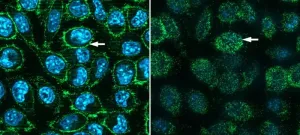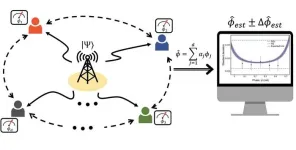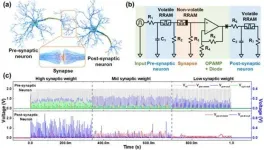Scientists trap krypton atoms to form one-dimensional gas
2024-01-22
(Press-News.org)
For the first time, scientists have successfully trapped atoms of krypton (Kr), a noble gas, inside a carbon nanotube to form a one-dimensional gas.
Scientists from the University of Nottingham’s School of Chemistry used advanced transmission electron microscopy (TEM) methods to capture the moment when Kr atoms joined together, one by one, inside a “nano test tube” container with diameter half a million times smaller than the width of a human hair. The research has been published in the journal of the American Chemical Society.
The behaviour of atoms has been studied by scientists ever since it was hypothesized that they are the basic units of the universe. The movement of atoms has significant impact on fundamental phenomena such as temperature, pressure, fluid flow and chemical reactions. Traditional spectroscopy methods can analyse the movement of large groups of atoms and then use averaged data to explain phenomena at the atomic scale. However, these methods don’t show what individual atoms are doing at a specific point in time.
The challenge researchers face when imaging atoms is that they are very small, ranging from 0.1 – 0.4 nanometres, and they can move at very high speeds of around 400 m/s in the gas phase, on the scale of the speed of sound. This makes the direct imaging of atoms in action very difficult, and the creation of continuous visual representations of atoms in real-time remains one of the most significant scientific challenges.
Professor Andrei Khlobystov, School of Chemistry, University of Nottingham, said: “Carbon nanotubes enable us to entrap atoms and accurately position and study them at the single-atom level in real-time. For instance, we successfully trapped noble gas krypton (Kr) atoms in this study. Because Kr has a high atomic number, it is easier to observe in a TEM than lighter elements. This allowed us to track the positions of Kr atoms as moving dots.”
Professor Ute Kaiser, former head of the Electron Microscopy of Materials Science group, senior professor at the University of Ulm, added: “We used our state-of-the-art SALVE TEM, which corrects chromatic and spherical aberrations, to observe the process of krypton atoms joining together to form Kr2 pairs. These pairs are held together by the van der Waals interaction, which is a mysterious force governing the world of molecules and atoms. This is an exciting innovation, as it allows us to see the van der Waals distance between two atoms in real space. It's a significant development in the field of chemistry and physics that can help us better understand the workings of atoms and molecules.”
The researchers utilised Buckminster fullerenes, which are football-shaped molecules consisting of 60 carbon atoms, to transport individual Kr atoms into nano test tubes. The coalescence of buckminsterfullerene molecules to create nested carbon nanotubes helped to improve the precision of the experiments. Ian Cardillo-Zallo, a PhD student at the University of Nottingham, who was responsible for the preparation and analysis of these materials, says: “Krypton atoms can be released from the fullerene cavities by fusing the carbon cages. This can be achieved by heating at 1200oC or irradiating with an electron beam. Interatomic bonding between Kr atoms and their dynamic gas-like behaviour can both be studied in a single TEM experiment.”
The group have been able to directly observe Kr atoms exiting fullerene cages to form a one-dimensional gas. Once freed from their carrier molecules, Kr atoms can only move in one dimension along the nanotube channel due to the extremely narrow space. The atoms in the row of constrained Kr atoms cannot pass each other and are forced to slow down, like vehicles in traffic congestion. The team captured the crucial stage when isolated Kr atoms transition to a 1D gas, causing single-atom contrast to disappear in the TEM. Nonetheless, the complementary techniques of scanning TEM (STEM) imaging and electron energy loss spectroscopy (EELS) were able to trace the movement of atoms within each nanotube through the mapping of their chemical signatures.
Professor Quentin Ramasse, Director of SuperSTEM, an EPSRC National Research Facility, said: ‘By focusing the electron beam to a diameter much smaller than the atomic size, we are able to scan across the nano test tube and record spectra of individual atoms confined within, even if these atoms are moving. This gives us a spectral map of the one-dimensional gas, confirming that the atoms are delocalised and fill all available space, as a normal gas would do.’
Professor Paul Brown, director of the Nanoscale and Microscale Research Centre (nmRC), University of Nottingham, said: ‘As far as we know, this is the first time that chains of noble gas atoms have been imaged directly, leading to the creation of a one-dimensional gas in a solid material. Such strongly correlated atomic systems may exhibit highly unusual heat conductance and diffusion properties. Transmission electron microscopy has played a crucial role in understanding the dynamics of atoms in real-time and direct space.’
The team plans to use electron microscopy to image temperature-controlled phase transitions and chemical reactions in one-dimensional systems, to unlock the secrets of such unusual states of matter.
END
ELSE PRESS RELEASES FROM THIS DATE:
2024-01-22
Electrical impedance tomography (EIT) is a non-destructive imaging technique used to visualize the interior of materials. In this method, an electric current is injected between two electrodes, creating an electric field, and other electrodes measure distortions caused by the presence of foreign objects inside the material. Compared to other imaging methods, such as X-ray imaging, computed tomography, and magnetic resonance imaging, EIT has the advantages of being low cost and less cumbersome as it does not require large magnets or radiation. Therefore, it holds great potential as a non-destructive structural health monitoring ...
2024-01-22
(COLUMBUS, Ohio) – A new study conducted by researchers at the Center for Injury Research and Policy of the Abigail Wexner Research Institute at Nationwide Children’s Hospital and the Central Ohio Poison Center investigated trends in calls to poison centers across the country for exposures to liquid laundry detergent packets. The study investigators identified declines in the number, rate and severity of liquid laundry detergent packet exposures among children younger than 6 years. However, the exposure burden remained high. Additionally, exposures have increased among older children, teens and adults.
The study, published in Clinical Toxicology, found that in the most recent ...
2024-01-22
Photos
A new University of Michigan-led international study finds that fruits and vegetables grown in urban farms and gardens have a carbon footprint that is, on average, six times greater than conventionally grown produce.
However, a few city-grown crops equaled or outperformed conventional agriculture under certain conditions. Tomatoes grown in the soil of open-air urban plots had a lower carbon intensity than tomatoes grown in conventional greenhouses, while the emissions difference between conventional and urban agriculture vanished for air-freighted crops like asparagus.
"The exceptions revealed by our ...
2024-01-22
UPTON, NY—A team of scientists at the U.S. Department of Energy’s (DOE) Brookhaven National Laboratory and Columbia University has demonstrated a way to produce large quantities of the receptor that SARS-CoV-2, the virus that causes COVID-19, binds to on the surface of human cells. That binding between the now-infamous viral spike protein and the human “ACE2” receptor is the first step of infection by the virus. Making functional human ACE2 protein in mouse cells gives scientists a new way to study these receptors and potentially put them to use. In addition, as described in a paper just published in the journal Virology, the ...
2024-01-22
Computer science researchers have developed a new way to identify security weaknesses that leave people vulnerable to account takeover attacks, where a hacker gains unauthorized access to online accounts.
Most mobiles are now home to a complex ecosystem of interconnected operating software and Apps, and as the connections between online services has increased, so have the possibilities for hackers to exploit the security weaknesses, often with disastrous consequences for their owner.
Dr Luca Arnaboldi, from the University of Birmingham’s School of Computer Science, explains: “The ruse of looking over someone’s shoulder to find out their PIN is well known. ...
2024-01-22
Because low-risk prostate cancer is unlikely to spread or impact survival, experts and guidelines recommend active surveillance, which involves regular monitoring and thus avoid or delay treatment like surgery or radiation therapy and their life-changing complications. A new study examined the rates of active surveillance use and evaluated the factors associated with selecting this management strategy over surgery or radiation, with a focus on underserved Black patients who have been underrepresented in prior studies. The findings are published by Wiley online in CANCER, a peer-reviewed journal of the American Cancer Society.
For the study, called the Treatment ...
2024-01-22
Researchers at Linköping University, Sweden, have developed a new, more environmentally friendly way to create conductive inks for use in organic electronics such as solar cells, artificial neurons, and soft sensors. The findings, published in the journal Nature Communications, pave the way for future sustainable technology.
Organic electronics are on the rise as a complement and, in some cases, a replacement to traditional silicon-based electronics. Thanks to simple manufacturing, high flexibility, and low weight combined with the electrical properties typically associated with traditional semiconductors, it can be useful for applications such as digital displays, energy storage, ...
2024-01-22
As young people increasingly have access and exposure to online gambling, only one in four parents say they have talked to their teen about some aspect of virtual betting, a national poll suggests.
But over half of parents aren’t aware of their state’s legal age for online gambling and one in six admit they probably wouldn’t know if their child was betting online, according to the University of Michigan Health C.S. Mott Children’s Hospital National Poll on Children’s Health.
“Teens and young adults may have a difficult time going ...
2024-01-22
We've all had the experience of trying to get the exact time of a highly competitive concert ticket or class beforehand. If the time in Seoul and Busan is off by even a fraction of an hour, one will be less successful than the other. Sharing the exact time between distant locations is becoming increasingly important in all areas of our lives, including finance, telecommunications, security, and other fields that require improved accuracy and precision in sending and receiving data.
The Korea Institute of Science and Technology (KIST) announced that Dr. Hyang-Tag Lim and his team at the Center ...
2024-01-22
With the emergence of new industries such as artificial intelligence, the Internet of Things, and machine learning, the world's leading companies are focusing on developing next-generation artificial intelligence semiconductors that can process vast amounts of data while consuming energy efficiently. Neuromorphic computing, inspired by the human brain, is one of them. As a result, devices that mimic biological neurons and synapses are being developed one after another based on emerging materials and structures, but research on integrating individual devices into a system to verify and optimize them ...
LAST 30 PRESS RELEASES:
[Press-News.org] Scientists trap krypton atoms to form one-dimensional gas







